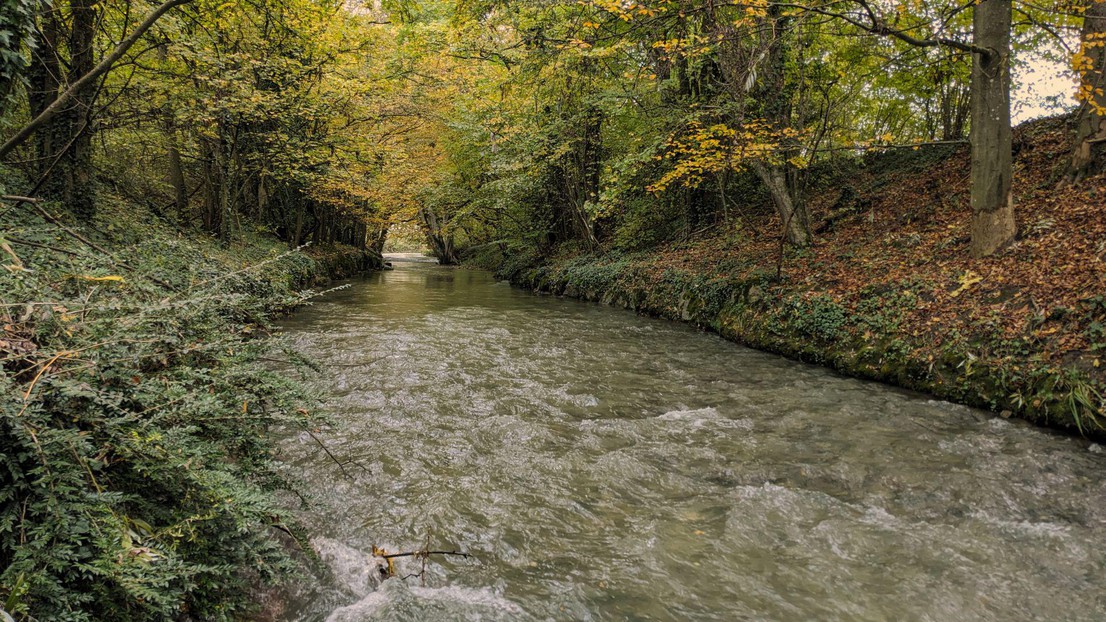A scientific network around the Chamberonne river

The Chamberonne river flows across both UNIL and EPFL campus. © 2025 UNIL
Scientists from UNIL, EPFL, and other institutions have joined forces to create a network aimed at turning the Chamberonne river – which flows across their campus – into an open-air observatory. Motivated by the major renaturation works starting next year on campus, the initiative aims to foster research and teaching projects centered on the river.
The Chamberonne is a small river formed by the confluence of the Sorge and Mèbre. Its 38 km² watershed carries it through the UNIL and EPFL campus before reaching Lake Geneva. Along its course, it traverses agricultural land, forested areas and heavily urbanized zones, making it a representative example of an urban river in Switzerland.
An inter-campus collaboration
At UNIL and EPFL, scientists are ideally positioned to conduct cutting-edge studies on this river. Several research projects are already underway, focusing on measuring pollution (microplastics, pharmaceuticals, contaminants), studying the effects of urban areas on streamflow, and assessing the river’s influence on the well-being of people on campus.
In 2026, the Canton of Vaud will launch a major renaturation project on the Chamberonne, which will involve widening its riverbed and creating a bird island at its mouth. This initiative presents an excellent opportunity to foster new collaborations, generate inter-campus synergies, and develop innovative teaching tools. “This renaturation will deeply change the river flow, its sediments and the interaction with groundwater and vegetation. It is the perfect moment to tackle the challenges of such a transformation together,” says Paolo Benettin, researcher at the Faculty of Geosciences and Environment (FGSE) at UNIL and former EPFL researcher.
Complex systems such as rivers require multi-disciplinary and multi-institution efforts
Under his leadership, and with the support of the FGSE, an initial workshop was organized, bringing together nearly 40 scientists from UNIL and EPFL working across a wide range of fields, from ecotoxicology and hydraulic engineering to robotics and forensic science (see below). “Complex systems such as rivers require multi-disciplinary and multi-institution efforts,” explains Rizlan Bernier-Latmani, researcher at EPFL’s ENAC faculty. Drawing on data from the Chamberonne, she and her team developed the “EPFL Water Portal”.
A Living Laboratory
During this first meeting, several ideas were discussed, including collaborative monitoring campaigns, the creation of a shared dataset accessible to students, the organization of dedicated courses – particularly on river pollution – and involving citizens in the initiatives. “We want the Chamberonne to become a living laboratory for teaching, research, and outreach projects,” summarizes Paolo Benettin. A follow-up workshop is planned for spring 2026.
All research is conducted in an environmentally friendly and non-invasive manner.
Are you a scientist, conducting research on the Chamberonne, or do you have project ideas related to the river? Please feel free to contact: [email protected]
More information on the Chamberonne and the renaturation project:
In French : projet Broye-Chamberonne / Broye-Chamberonne: Gestion des crues et renaturation /
In English: The Chamberonne experimental catchment
Network participants and research on the Chamberonne
UNIL Groups:
UNIL FGSE – Hydrology*
UNIL FGSE – Ecotoxicology*
UNIL FGSE – AlpWise*
UNIL FGSE – Soil and Vegetation Research*
UNIL FGSE – Reynard Group*
UNIL FGSE – Salomon Cavin group*
UNIL FGSE – Hydrometeorology
UNIL FGSE – LAKES
UNIL FBM – Christe Group *
UNIL FDCA – Weyermann group*
UNIL Lettres – HIST
UNIL SCMS – L'éprouvette*
EPFL Groups:
EPFL ENAC – SOIL*
EPFL ENAC – EML*
EPFL ENAC – URBES*
EPFL ENAC – CEL*
EPFL ENAC – PL-LCH*
EPFL ENAC – Limnology Center*
EPFL ENAC – PERL
EPFL ENAC – LSR*
EPFL ENAC – STREEM*
EPFL ENAC – RIVER
EPFL Ecotox center*
Others:
HEIG‑VD*
WSL*
HEPIA*
VSA*
Ville en Tête*
* present at the workshop